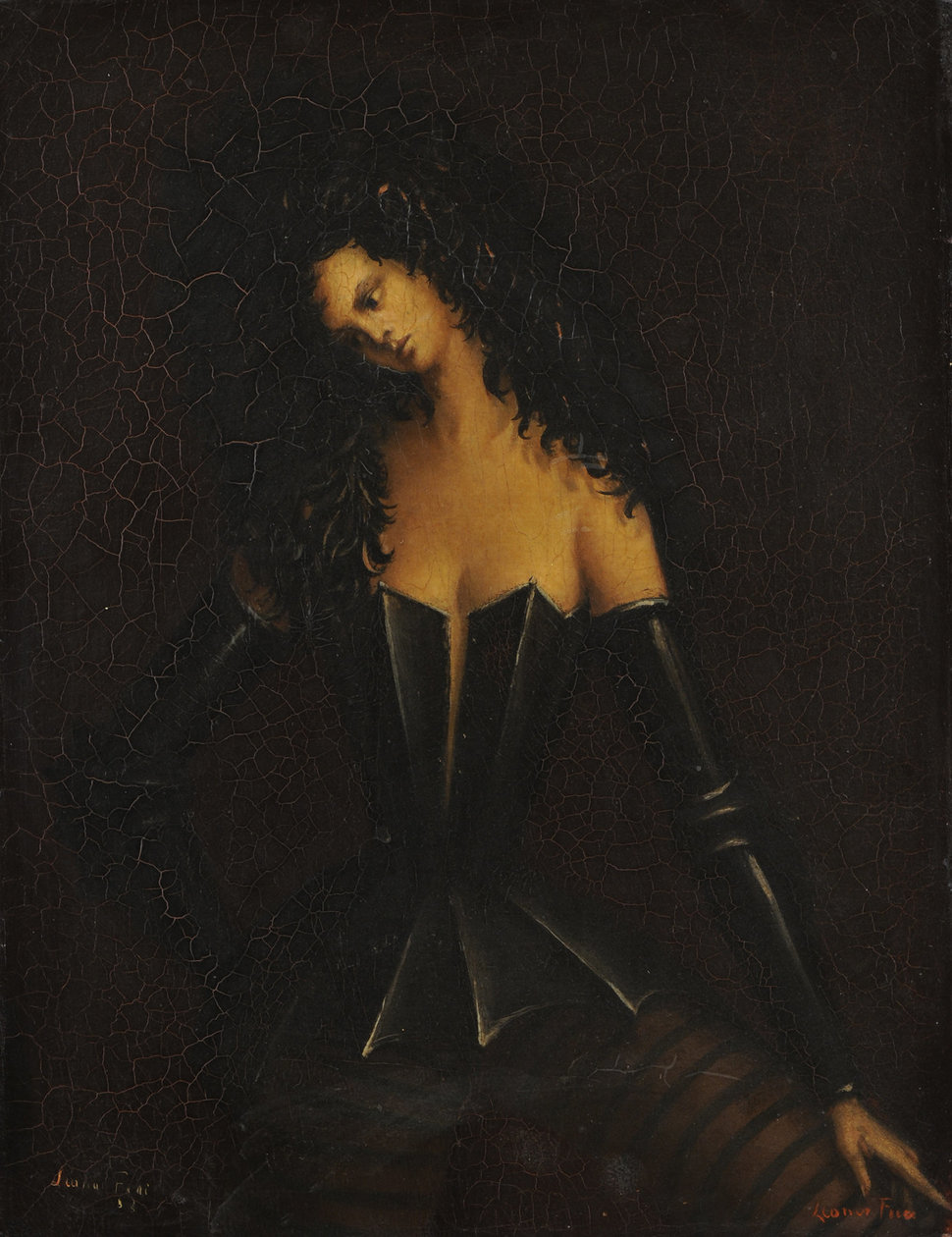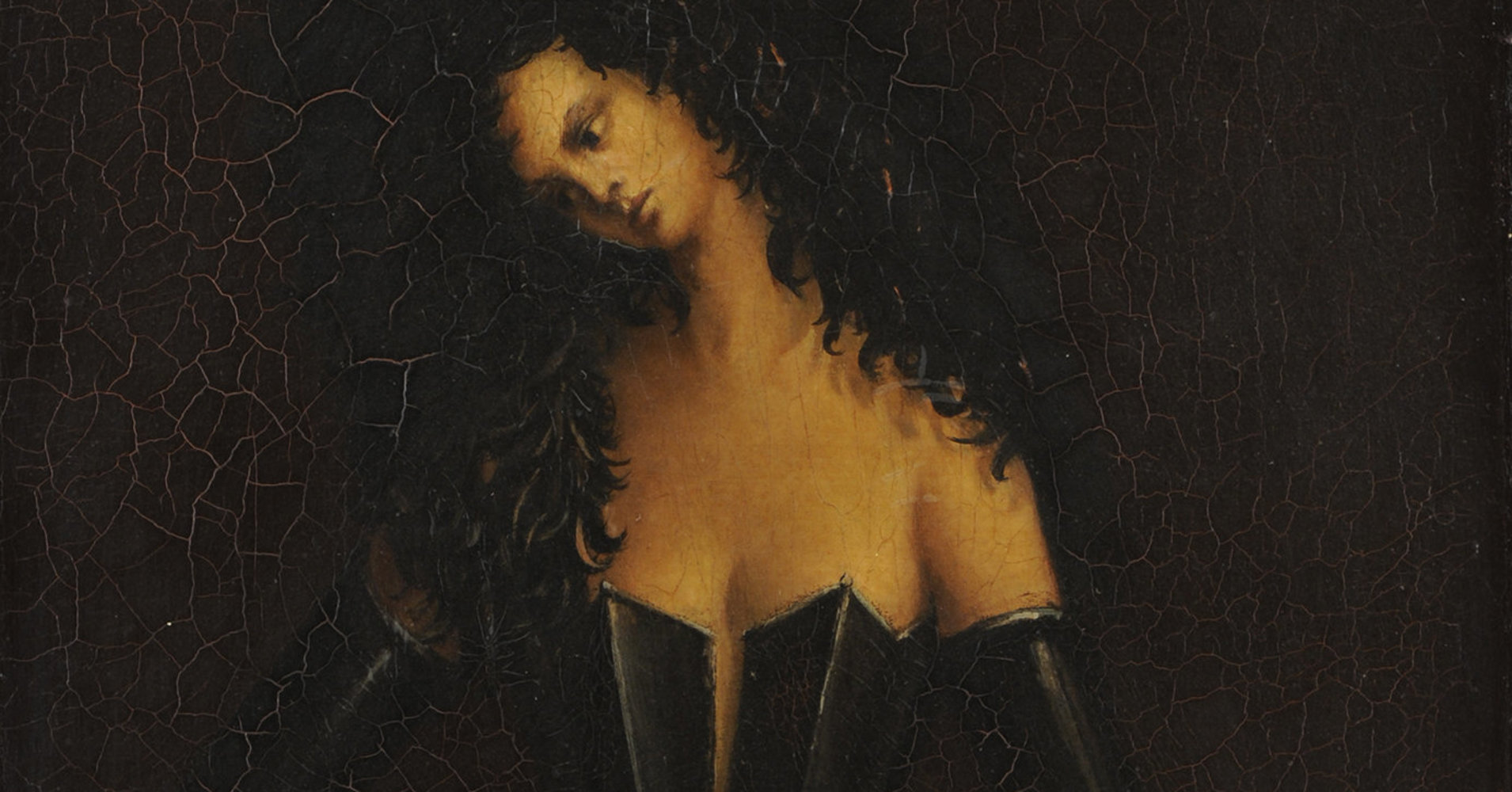[ad_1]
Leonor Fini was about 3 years old when she first felt the transformative power of a costume. In a 1966 documentary, she recalled watching her mother and a friend dress up as characters from a children’s book she loved. Fini was “horribly terrified” by what she saw.
“I was used to seeing these characters in two dimensions,” she explained. “When I saw them in real life it sparked a terror in me that I’ve never forgotten.”
Yet somewhere beneath the fear flickered a hint of fascination, one that mushroomed as Fini grew into an adult, as well as a famous Surrealist artist and costume designer. In the 1930s, she earned a well-documented reputation for navigating Parisian high society in avant-garments that were absolutely un-categorizable. Cat ears, owl masks, molten metal crowns, crystal skullcaps, gilded horns ― all were trusted accessories in her arsenal.
Decades after watching her mom dress up with horror, Fini made and wore costumes not just to enact fairy tales or make-believe; they became elements of her everyday existence. The effect was profound. Fini avoided expectations traditionally thrust upon women at the time ― that they subsume a modest and demure disposition. Her costumes (better described as uniforms, given that she was never not in costume) conveniently deterred the leering attention of male suitors who might want to saddle her with the conventions of a monogamous relationship, marriage or children. But the costumery wasn’t for them.
The primary audience of Fini’s garb-centric performances was always herself.
Fini’s finest threads (and bones and feathers) are currently sitting inside New York’s Museum of Sex in an intoxicating exhibition called “Leonor Fini: Theatre of Desire 1930-1990.” Today, the elaborate costumes she designed and modeled speak to a feminine language of power that’s still very much communicated in the stuff of women’s closets.

Estate of Leonor Fini
For women, clothes can be a weapon to be used or used against them. In public and professional settings, the things we put on our backs are often considered in terms of their effect on men. If a hem length or neckline deviates from established norms of feminine decency, they’re deemed a distraction to the males who must encounter them ― or worse, an invitation. “What were you wearing?” ― a question frequently lobbed at women recounting experiences with sexual harassment or assault ― suggests modesty is the most viable strategy for self-preservation.
For Fini, however, dressing up and outside of the professed standards was a power source and a spiritual rite. “I have always liked dressing up in costumes,” she said. “There is an element of expanded size, stretching way out, the glorification of one’s self.”
Fini, born in 1907 in Buenos Aires, moved to Italy with her mother and grandmother as a young girl, in part to create distance between themselves and Fini’s abusive father. After he managed to track Fini down and attempted to kidnap her, she started dressing as a boy to avoid detection. It was a means of survival, but menswear provided Fini a source of experimentation and play, too.
“I like to feel myself in a state of metamorphosis like certain animals and plants,” Fini said in 1968. “It is a need for a change of dimension more than a need for defense.”
Fini rebelled against societal niceties throughout her adolescence by, for example, habitually hanging out at the morgue. Her penchant for the macabre continued into adulthood, and she developed an interest in occult practices and lore.
Her artistic career began in 1929 when she exhibited her work for the first time in a group show in Milan. Two years later she relocated to Paris, where she fell in with iconic Surrealists including Salvador Dali, Man Ray and her former lover Max Ernst. In 1936, she took part in the Museum of Modern Art’s pivotal “Fantastic Art, Dada and Surrealism” exhibition alongside Jean Arp, Hans Bellmer, William Blake, Joseph Cornell and Marcel Duchamp.
During this time, the love Fini had for clothing became metaphysical. In her 1943 “Self-Portrait with Stanislao Lepri,” Fini depicts herself alongside her real-life lover, an Italian diplomat and amateur artist. (Lepri and Fini were in a long-term relationship with Constantin “Kot” Jeleński, a Polish writer.) In the painting, Fini is a hybrid many times over. She is a sphinx ― the mythical half-lion, half-woman renowned for her shrewdness ― captured in the process of melting into a tangled knot of vines and leaves. Clearly one alter ego wasn’t enough.
In other paintings, like “Male Nude/Portrait of Nico Papatakis” (1942) and “Chthonian Deity Watching Over the Sleep of a Young Man” (1946), Fini depicted unadorned and androgynous nude men in docile repose, their luminous flesh and willowy frames without costume. Primarily, however, Fini painted women, “because they are a projection of myself,” as she put it. “Because I am mostly interested in myself, and women are me.”
While her male subjects were often scantily clad, Fini always made sure her female subjects were painfully well dressed, often in clothing culled from the artist’s own closet. In the 1946 “Portrait of a Woman with Acanthus Leaves,” an unnamed woman with an exaggerated, nacreous forehead dons a bird skull as coronet. Her dress features a collar made of acanthus leaves, swirled elegantly into oversized swoops like decorative frosting. The bird skull look was one Fini rocked herself, as archival photos from the era prove.
Fini also drew inspiration from her own closet for a piece called “Woman in Armor,” in which a woman with black feathers for hair dons a metal corset part medieval armor and part BDSM. It simultaneously attracts and repels the male gaze like a DEET candle luring mosquitos to their deaths.

Courtesy of Weinstein Gallery, San Francisco
Fini didn’t just wear clothes with wicked flair, she designed them as well. She created costumes for almost 70 productions throughout Paris ― ballets, operas, plays and films ― favoring bawdy comedies in which “the details of physical experience can become part of the action,” she said.
“I enjoy using costume as a kind of gag, an integrated element in the development of the play’s action.”
Her 1968 designs for the play “The Council of Love,” in which God generates syphilis to punish mortals’ widespread debauchery, took dirty jokes to surreal, visual extremes. The actors portraying the pope’s clergy wore red coats and matching, striped pantaloons that failed to contain their inflated erections, which stretched up to their nipples. The women’s white gowns were almost bridal ― save for the oval holes carefully crafted to reveal their breasts, belly and thighs.
And yet Fini’s most memorable outfits were incontrovertibly those she wore herself. Fini found the balls of Parisian society to be boring, but she relished her entrance to each, what she called the “first and unique moment,” which promised the chance “to be drunk with myself for one minute.”
A video at the Museum of Sex scrolls through some of Fini’s most iconic looks on loop. One particularly arresting shot zooms in on her face, which is masked entirely by a knotted wood facade with circular holes where eyes and a mouth should be. Fini seductively removes the mask only to reveal another underneath, this one as black as a void. She takes that off too, only to reveal another mask, one that’s partially translucent. Silver gems form diamond patterns that run down Fini’s forehead and nose atop a black mesh base.
You could imagine this game going on forever, one mask hiding another, and then another, and then another.
Today, women continue Fini’s legacy of shapeshifting as a mode of rebellion and expression. Celebrities reinvent their public images on a massive stage, while teenagers experiment with new styles and personas online in their bedrooms. But Fini was a true auteur, whose visionary influence didn’t discriminate between canvas and closet. To channel her creative prowess, don’t wait until October’s final days to whip out a costume.
[ad_2]
Source link

